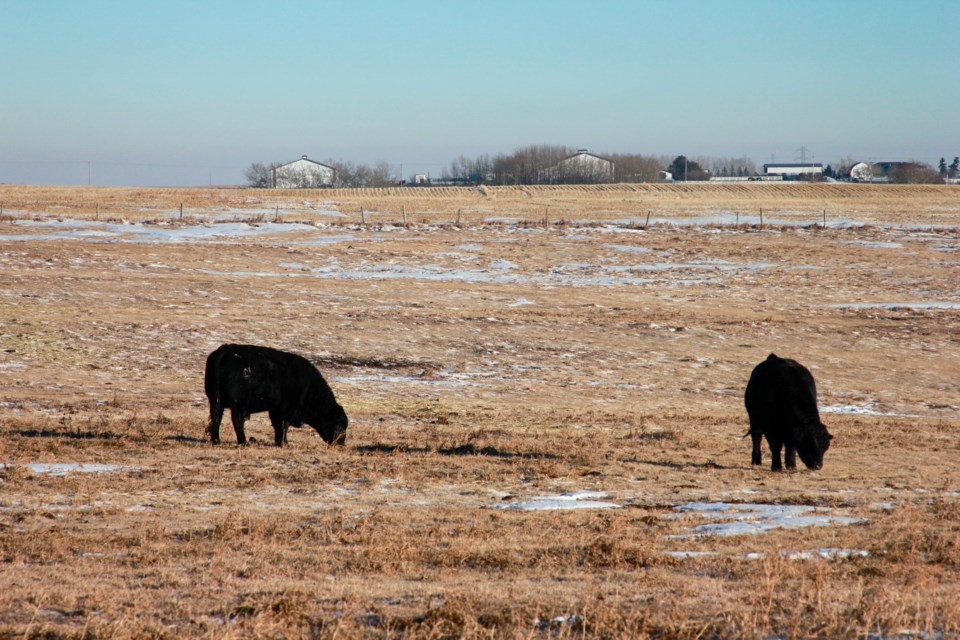Often when local farmers and ranchers are thinking about stewardship, they are thinking of the practical things they can do on their lands to lessen their environmental footprint while making their operations more sustainable at the same time.
That’s where Alternative Land Use Services (ALUS) comes in, says Rocky View County agricultural services officer and ALUS coordinator, Matthew Chilakos.
“ALUS provides expertise, resources, and direct financial support to communities where farmers and ranchers build nature-based solutions on their land to deliver ecosystem services,” he explained in a recent interview.
According to Chilakos, projects funded by ALUS include the installation of infrastructure like fencing around wetlands or water systems to provide a riparian buffer, offsite waterers so cattle won’t be drinking directly from (and potentially contaminating) a creek or river system, and solar-powered waterers to provide water further afield from the creekside with energy efficiency.
ALUS also may provide payments to producers for acres returned to a more natural state or preserved from cultivation, Chilakos added.
Funding for ALUS comes from national donor organizations that provide dollars for local farmers and ranchers for these types of stewardship projects through a local Partnership Advisory Committee (PAC) under RVC’s Agricultural Services Board.
According to Chilakos, the local ALUS PAC provides about $35,000 to $40,000 per year in matching grants of up to 50 per cent to complete these watering and preservation projects.
“With up to 50 per cent of establishment fees covered by ALUS, it is definitely a good incentive for farmers and ranchers to jump on the program,” he stated.
That funding, said Chilakos, has been fully used up over the past three years ALUS grants have been available, and is usually allocated on a first come first serve basis if the projects meet the initial criteria under the program.
RVC’s ALUS PAC chair is Div. 5 Coun. Greg Boehlke, who said he would actually like to see more uptake on ALUS funding from local farmers and ranchers. But Boehlke acknowledged the uncertainty of the amount of funding available each year with these relatively low dollar amounts attached doesn't incentivize as many local producers to access the program as maybe it should.
“There has always been some kind of program to help incentivize farmers and ranchers with different things like fencing off certain environmentally sensitive areas,” he explained. “But I am not quite certain if (ALUS) is not known enough through the county, or maybe it is a little cumbersome for people. I don’t know what it is, but it is not super well-used. It’s minimal dollars, and a lot of the involvement is word-of-mouth.”
Boehlke said applying for the program makes sense if a farmer or rancher wants help in funding a relatively small-scale sustainability project, but perhaps loses some usefulness for larger scale and more cost-prohibitive projects.
The veteran councillor pointed to the example of the documented contamination of local waterways like Nose Creek, where cattle operations are allowed to water directly from the creek. Cattle prefer off-site watering areas where the water can be pumped in cleanly if given a preference, he argued, but fencing off a large creekside riparian area can get expensive.
ALUS can help with some of that cost, acknowledged Boehlke, but not all. He gave the example of Crossfield Creek, which crosses through an unfenced quarter section of his own property.
“To fence that off would be a pretty substantial dollar to fence that creek off, and it’s only part of a quarter section,” he stated. “It would be very substantial to do it, and really for a part-time flowing creek, I am not sure it (the cost-benefit) weighs out.”
In order for ALUS to be more effective in incentivizing greater local stewardship, Boehlke argued it needs to have more dollars available and more stable yearly funding to make it truly accessible and useful.
Chilakos agreed with Boehlke that there could be more uptake from local ranchers and farmers, but also acknowledged that part of that initiative has to come from the local producers themselves. The more local demand for ALUS funds, the more national and provincial ALUS funds he can apply for through Rocky View County.
The key, Chilakos said, is for local farmers and ranchers to submit more proposals through RVC to fuel that ask and bring more ALUS funds into the county.
“We are using 100 per cent of the money that we have access to,” he stated. “But if we get a lot of buy-in this year, that is not to say if we have a lot of uptake I can’t potentially ask for more money. We had three completed projects this year. We had four or five last year, and the same the year before. So for sure there is interest, and we definitely have a few projects every year.”
For more information on ALUS, visit alus.ca. To apply for ALUS funds, visit the County website (Rockyview.ca) under the Agriculture tab. Applications can be found under Agri-Environmental Programs and Grants.




